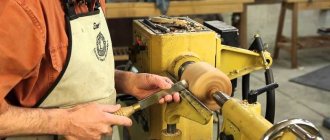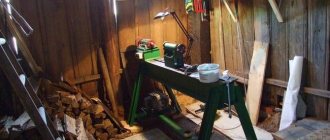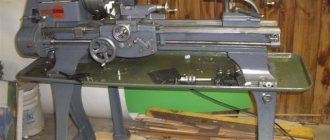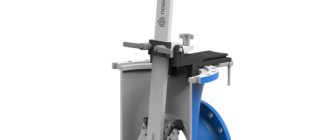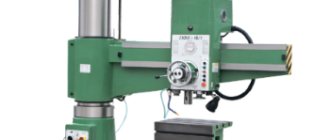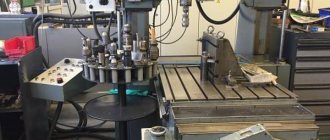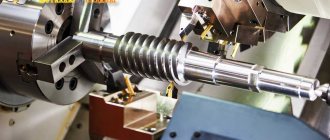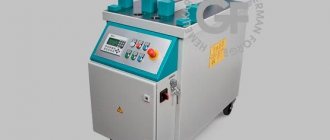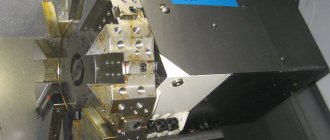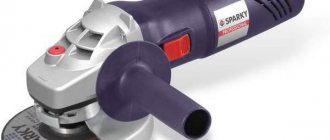In a home workshop, a circular saw will occupy a special place. The fact is that it is he who will play the most important role in all work related to wood processing. A circular saw for wood will perform most of the operations of cutting wood, leveling and adjusting the size of planks. In fact, all work related to wood processing will begin with it, however, provided that the equipment is selected correctly according to its parameters.
Design features of circular machines
To thoroughly understand what a circular saw is and what functions it can perform, you need to understand the principles of its operation and what parts it consists of. The operating principle of a circular saw is to use a rotating circular saw mounted on a stationary bed. The working body is a saw blade - a steel disk with teeth that have one-sided or multi-sided sharpening, used for cutting wood, chipboards or other wood materials. Unlike hand-held circular saws, a circular saw in most cases uses a belt drive, which increases the capabilities of the machine during operation.
The basis of the device is the frame - a monolithic or prefabricated structure that serves as the basis for mounting an electric motor, a working shaft with knives, a saw blade and other structural elements or devices, for example, a carriage. It is worth mentioning right away that most designs use an electric motor, but there are exceptions, for example, devices with a gasoline or diesel engine. There are few such devices, but they exist and are used to work in places where there is simply no electricity.
In addition to purely circular saw machines, there are many tools with an extended shaft on which planing knives are mounted. Such devices, by analogy with hand tools, are called a plane or jointer. The plane has a small width and length of the working plate, which is why it can only plan small planks and boards. The jointer is another matter - its width can be 200, 250, or even 400 mm. And its working plate is much longer, so achieving high quality of the workpiece on a jointer is much easier and more convenient.
Advantages of circular units for wood
Despite the simplicity of the design and limited functionality, the circular machine has a number of advantages:
- dissolving lumber requires a minimum of time: a six-meter tree trunk is sawed at high speed, on average in 10–15 seconds;
- output material – in a high percentage suitable for processing by the radial method;
- the output raw material remains of high quality;
- clear geometry;
- optimally smooth cut;
- considerable productivity at the level of an industrial machine;
- copes with dirty, resin-coated trunks, rather hard rocks using cutters made of carbide steel;
- any type of cutting is carried out, without additional sorting of lumber;
- low costs for saw blades.
It is the circular machine that is used in order to save money at sawmills, where residual material is also consumed. Compact modifications are no less productive. In a home workshop, a mini-circular machine gives excellent results, and the practicality of the variation is obvious.
After cutting, a jointer is used to process the cut. The surface becomes smooth.
The woodworking circular saw is produced in several types. They differ in design features:
- tabletop structures (hand circular saw) that require installation on a frame;
- stationary circular saw;
- sawing structures with an extended bed.
Homemade woodworking machine
Purpose
Circular saws are mainly classified as woodworking machines, but they can be used to cut plastics and even asbestos-cement boards. But still, they are intended for sawing boards, cutting chipboards and fiberboards, as well as plywood.
Household, however, as well as professional machines can be:
- Portable;
- On a stand;
- Stationary.
To perform simple operations with small workpieces, only a saw is usually used, without additional equipment or accessories. But for such work as cutting chipboard slabs, it is also necessary to use a carriage or a special format table in the machine kit to cut a dimensional sheet of material.
Universal circular saw machine Ts6-2 (K)
| 1. The greatest width of the sawn material when basing the material on the machine table along the guide ruler, mm. | 600 |
| 2. The greatest width of the sawn material when basing the material on a movable carriage along a guide ruler, mm. | 600 |
| 3. Maximum thickness of the material being cut, mm. | 150 |
| 4. The largest dimensions of the processed groove (quarter, tongue) in one pass, width x depth, mm. | 10x20 |
| 5. Largest saw diameter / bore diameter, mm. | 400/50 |
| 6. Largest cutter diameter / bore diameter, mm. | 180/40 |
| 7. Rated rotation speed of the cutting tool, rpm. | 2860 |
| 8. Nominal dimensions of the working surface of the machine table, length x width, mm: | 1180x1000 |
| 9. Nominal dimensions of the working surface of the movable carriage table, length x width, mm: | 680x580 |
| 10. Maximum stroke of the carriage, mm. | 1110 |
| 11. Level of the working surface of the table from the floor, not less than mm. | 790 |
| 12. Overall dimensions of the machine, (length x width x height), mm: | 1790x1900x1240 |
| 13. Machine weight, kg. | 650 |
| Characteristics of electrical equipment | |
| 14. Number of electric motors on the machine, pcs. | 1 |
| 15. Electric motor power, kW. | 4 |
| 16. Synchronous rotation speed of the electric motor, rpm. | 3000 |
| Data for exhaust system | |
| Air flow not less than, m3/h; | 1000 |
| Air speed in the outlet pipe, m/s; | 20 |
| Aerodynamic drag coefficient | 3 |
Types of circular machines
There are several classifications of circular machines. The first and most significant is the history of the origin of the equipment. It may look unusual, but this is exactly the one with which you should start getting acquainted with the types of equipment:
- Industrial production machines;
- Handicraft machines.
Equipment manufacturers, in turn, divide machines into the following classes:
- Portable machines;
- Machines using supply;
- Stationary circular saws.
By purpose, the equipment can be divided into:
- For machines of universal household use;
- Professional machines.
Depending on the tasks that the device can solve, the following classification can be made:
- Circular saws for longitudinal cutting;
- Circular saw with cross-cut carriage;
- Multifunction device;
As for the size, it can be a mini version of the circular saw for use in an apartment or house, or it can be a portable model for installation on a table or on a special stand. Or there may be a full-size model that requires installation on a specially prepared foundation.
Thanks to its small size, this mini tabletop circular saw can be used as the main equipment for modeling or creating crafts. A format circular saw usually has impressive dimensions and is designed for cutting sheet material. For universal and multifunctional models, the presence of auxiliary equipment plays an important role, allowing you to make not only longitudinal, but also transverse cuts of the material.
Home mini-circular devices
Household mini-circular machines used by private individuals are endowed with their own characteristics. They are distinguished by limited functionality - performance is not industrial. A circular saw has low power, models are supplemented with discs, the diameter should be small. The largest parameter of a straight cut is not as large as that of industrial ones (range from 40 to 80 mm).
When choosing household sawing machines, you must remember that it is strictly forbidden to use them in processing large workpieces. Their task is to cope with the processing of workpieces of small width, ranging from 300 to 625 mm. Features of models of this class are considerable noise and vibration produced. There are several explanations. Household sawing machines operate on a direct drive and a gear reducer.
Their power is sufficient for simple wood cutting tasks. It is possible to process fairly dense material with high rigidity. But the machines have important advantages - for example, affordable cost.
How to choose a circular saw
The main criterion for choosing equipment for a home workshop should be the feasibility of purchasing this equipment. For the home, a device with small dimensions and a large number of functions is considered the optimal choice.
For use in a small workshop, you should pay attention to a planing and sawing machine with the ability to cut material up to 125 mm. The frame of such a device is recommended to be cast iron, and the engine should have a power of at least 2.2-2.4 kW.
For beginners, it is recommended to purchase a tabletop version of the circular saw or a model with a stand. And even if the cutting depth is only 85-100 mm, it will be enough to develop skills in working with such a device.
Regarding the choice of engine power, it is recommended to pay attention to equipment with an engine from 1.1 kW.
As for the current consumption, for those who have experience working with such machines, it is better to choose machines operating from a three-phase network of 380 V, and for beginners, a household network of 220 volts is sufficient for simple work.
Specifications
The power potential of the machine, in particular, will determine what format of workpieces it can work with. The average power is 1200-2400 W. Accordingly, household units have a small power reserve of up to 1500 W, and high-performance industrial machines can also have 3000 W motors. This technique with diamond discs can also handle metal workpieces. By the way, powerful equipment is connected to a three-phase network of 380 W, and small-sized amateur machines work with 220 W sockets.
No less important is the cutting depth parameter. It is determined by the standard size of the disk - from 200 to 305 mm. Accordingly, it will be possible to obtain cuts from 60 to 85 mm. The overview of circular machines presented below will help you become more familiar with the different types of this equipment, as well as their operational features.
How to make your own circular saw for home
Theoretically, you can make any machine yourself, provided you have all the spare parts and equipment for the job. But in order to assemble a home circular saw, and even with the function of planing wood, you must first of all purchase a working shaft. This is the most important and expensive element of the design.
The fact is that it is extremely difficult to make such a shaft yourself without a lathe and milling machine. The shaft is not only machined with great precision, but after installation on the supports it is centered and aligned. At a rotation speed of 3000 rpm, the shaft should have minimal or no runout. But if it exhibits noticeable beating, it may cause device failure or even serious injury.
The second important element of the machine is the electric motor. It is selected depending on the diameter of the saw blade. The larger the diameter of the disk, the more powerful the engine needed. For modeling, you can take a 450 W motor, but in this case the disk diameter should be no more than 100 mm. For a disk with a diameter of 150-160 mm, a motor with a power of 1.6 kW is required; for a circular saw with a diameter of 170 mm, a power of no less than 2.0 kW will be required.
For the design of the frame, a steel angle or channel is selected. If the circular machine is planned to be stationary with a powerful engine and a large disk, then the design should be massive. Therefore, the corner must be no less than 60x60 mm or a channel with a width of 60 mm or more.
A belt drive is used to transmit rotational motion from the engine to the working shaft. Here it is better to use a V-belt. You can try a flat belt, but a V-belt is still considered the best option for use in such a homemade product.
The slab should be as smooth and durable as possible. Therefore, in order to make a desktop, it is recommended to choose a metal plate with a thickness of 4-5 mm. Before installation on the frame of the bed, the plate must be checked and aligned.
It is especially necessary to focus on security issues. First of all, this concerns the controls - the electrical equipment unit must be carefully insulated, and the switch must have an emergency shutdown button. It is recommended to install a limiting device above the saw, similar to industrial designs, so as not to accidentally get your hand into the saw blade. In addition, the pulley and belt drive must be covered with a protective cover.
Machines with extended platform
By increasing the working space, the design allows large-format workpieces to be placed on the table, which expands the functionality of the unit. Such machines are more productive and powerful than their household counterparts, but the size is not suitable for every workshop. When unfolded, a circular machine of this type allows you to process workpieces whose width is about 1300-1400 mm. For ease of physical handling of the equipment, some designers include support legs and a wheelbase in the design.
As for the cutting depth, it is 85-90 mm. For home use there is little point in purchasing such machines, but in a carpentry workshop they turn out to be good helpers. However, the cost of a circular saw with an extended working base is considerable - 15-20 thousand rubles. for the medium power model.
Rules for safe operation
A circular saw is one of the most dangerous types of home equipment. Before starting work, it is necessary to clear the working space around it and check that the device is securely installed on the frame.
When working, it is recommended to have clothing that protects your arms and legs. To protect your eyes and face, you must wear a protective mask or safety glasses.
For sawing wood, take pieces no more than twice the length of the working surface of the circular saw. If there is a need to process workpieces of greater length, then a longitudinal feed carriage is mandatory.
It is important to remember that the engine is turned on first, and then the workpiece is brought to the saw blade, and not vice versa. You need to work on the machine from the side where the power button is located.
By following these simple rules, you can quite easily select the optimal equipment option for your home and in a short time learn how to perform several technological operations.
Advantages and disadvantages
Among the main advantages it is worth highlighting:
- fairly simple equipment
- ease of use
- high level of reliability when working in winter
- in a circular saw, long-term operation of several saws is possible, the maintenance of which does not require expensive sharpening equipment
- high level of productivity.
Among the main disadvantages, experts identify:
- a lot of waste due to the fact that the cutting width between the circular saws reaches 6-7 mm
- not quite clean cut resulting from vibration of the disc
- Saw sharpening should only be carried out by a trained specialist.
Universal circular saw machine Ts6-2K
Designed for longitudinal, transverse and angled sawing of boards, bars, furniture panels and other lumber. It is used in carpentry, construction and furniture production.
The machine bed has a box-shaped shape, inside of which there is a dust collector casing, which simultaneously serves to collect sawdust and connect to an external suction unit through a pipe. A guide for the carriage is attached to the frame using brackets. Electrical equipment is mounted in the niche of the frame. The saw is mounted on the shaft of an electric motor mounted on a swinging sub-motor plate, the axis of which is locked in the frame. Behind the saw, on the bracket of the sub-motor plate, a riving knife is fixed, designed to protect the saw from being clamped in the cut and to prevent the lumber from being thrown out. A guard mounted on the machine table covers the top of the saw and keeps the workpiece from being thrown out during the sawing process.
Specifications:
| The largest width of the sawn material when basing the material on the machine table along the guide ruler, mm | 600 |
| The largest width of the sawn material when basing the material on a movable carriage along a guide ruler, mm | 600 |
| Maximum thickness of sawn material, mm | 150 (120) |
| The largest dimensions of the processed groove (quarter, tongue) in one pass, mm, width/depth | 10/ 20 |
| Largest saw diameter/ bore hole diameter, mm | 450/ 50 |
| Largest cutter diameter/bore diameter, mm | 180/ 40 |
| Cutting tool rotation speed, rpm | 2860 |
| Dimensions of the working surface of the machine table, mm | 1180x1000 |
| Dimensions of the working surface of the movable carriage table, mm | 580x680 |
| Stroke of the moving carriage, mm | 1110 |
| Level of the working surface of the table from the floor, mm | 790 |
| Electric motor power, kW | 4 (5,5) |
| Overall dimensions, mm | 1790x1900x1240 |
| Weight, kg | 650 |
Combination calculator
Variety of models
A stationary circular saw for wood is in demand for performing a large volume of work. Most often they can be found on construction sites or in specialized workshops.
At home, compact models are more relevant, for example, tabletop circular devices or manual types of devices. The latter are convenient to use directly at the installation site, without moving heavy dimensional workpieces.
Sawing models can be classified according to the depth of cut. Conventionally, the machines are divided into three groups:
- Lightweight
Allows you to provide a cutting depth within 4-5 cm. This type is suitable for use outside production workshops if it is required that a woodworking mini circular unit unravel beams and boards of small thickness.
- Average
A universal group that includes circular saws for wood, designed for sawing up to 50-65 mm. The models are perfect for most DIYers or small production shops.
- Heavy
The group uses equipment and circular saws capable of processing workpieces up to 150 mm, and sometimes more. This will be powerful stationary equipment for wood, in demand in industrial settings.
Before you go to the store to buy saws, you need to decide on your current needs so as not to overpay or buy a low-power saw unit. Manual models are sufficient for solving most household tasks. They handle depth of cut and have moderate power.

